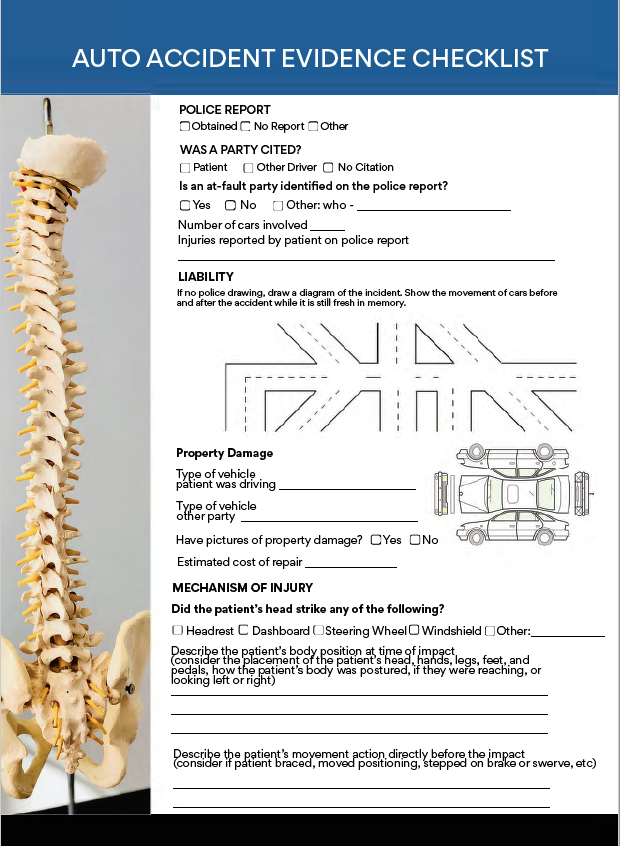Protecting your clients in an auto injury case
Provide you and your patients with the tools to succeed in an injury claim.
When treating patients that have been in a car accident, it is important to recognize that you, the health care provider, have no advocate in the process. Insurance companies are armed with adjusters and attorneys. Patients, if they’re smart, have attorney representation. However, the healthcare provider stands alone.
You must advocate for yourself by:
- Evaluating the claim;
- Educating the patient;
- Planning for and justifying your patient’s care; and
- Protecting yourself
You can start this process by collecting evidence that not only helps the patient’s case but gives you an accurate understanding of the accident and injuries.
Our Auto Injury Evidence Intake includes a checklist and questionnaire that collects the following evidence:
LIABILITY- Who is at fault for the accident
Get copies of the police report, photos of the damage, and repair estimates to evaluate the accident and the patient’s reported injuries.
Clients never believe they are at fault. They frequently tell a health care provider that the other party caused the accident and admitted their fault at the scene. Getting copies of the police report and vehicle photos help you to interpret the details of the accident. Your ability to get paid often depends on the liability determination.
MECHANISM OF INJURY- How the injuries occurred
Find out what the patient was doing and how they were positioned at the time of the collision. Document the injuries and causes through carefully written analysis of the accident.
Patients usually describe an automobile accident as a “big impact,” to them. It feels like a severe accident– never as a little “bump.” For insurance companies, low vehicle damage is considered indicative of the severity of the impact. However, you should investigate into the evidence of the impact- ask for photos and damage repair estimates to get an accurate picture of what your patient will be up against. If you understand the dynamics of the collision, you will be in a better position to explain the mechanism of injury and necessary treatment.
EVIDENCE OF INJURY- Documentation of treated and untreated injuries
“Objectify” your patient’s injuries with documented evidence. Document all injuries, treated or untreated, to paint a picture of the accident and the effects it had on the person.
Patients may come in with injuries that they do not need to seek treatment for (bruising, minor cuts, etc.) and may not even bring up to you. It is important that, although you will not treat these injuries, you take pictures and document them in the patient’s records as evidence that can be used to prove severity of injuries to the insurance company.
Gaps in treatment decrease the chances of a successful case. The longer the gap in treatment, the less likely a physician is able to relate the subsequent treatment to the initial traumatic event. Calling a patient and noting the phone consultation in the notes is a good way to “bridge the gap” for patients.
The opposing side’s expert medical providers and adjusters review all the evidence, why shouldn’t you?
Download our Auto Injury Evidence Intake and use this during your intake process with new auto accident patients to make sure you and your patient are protected.

